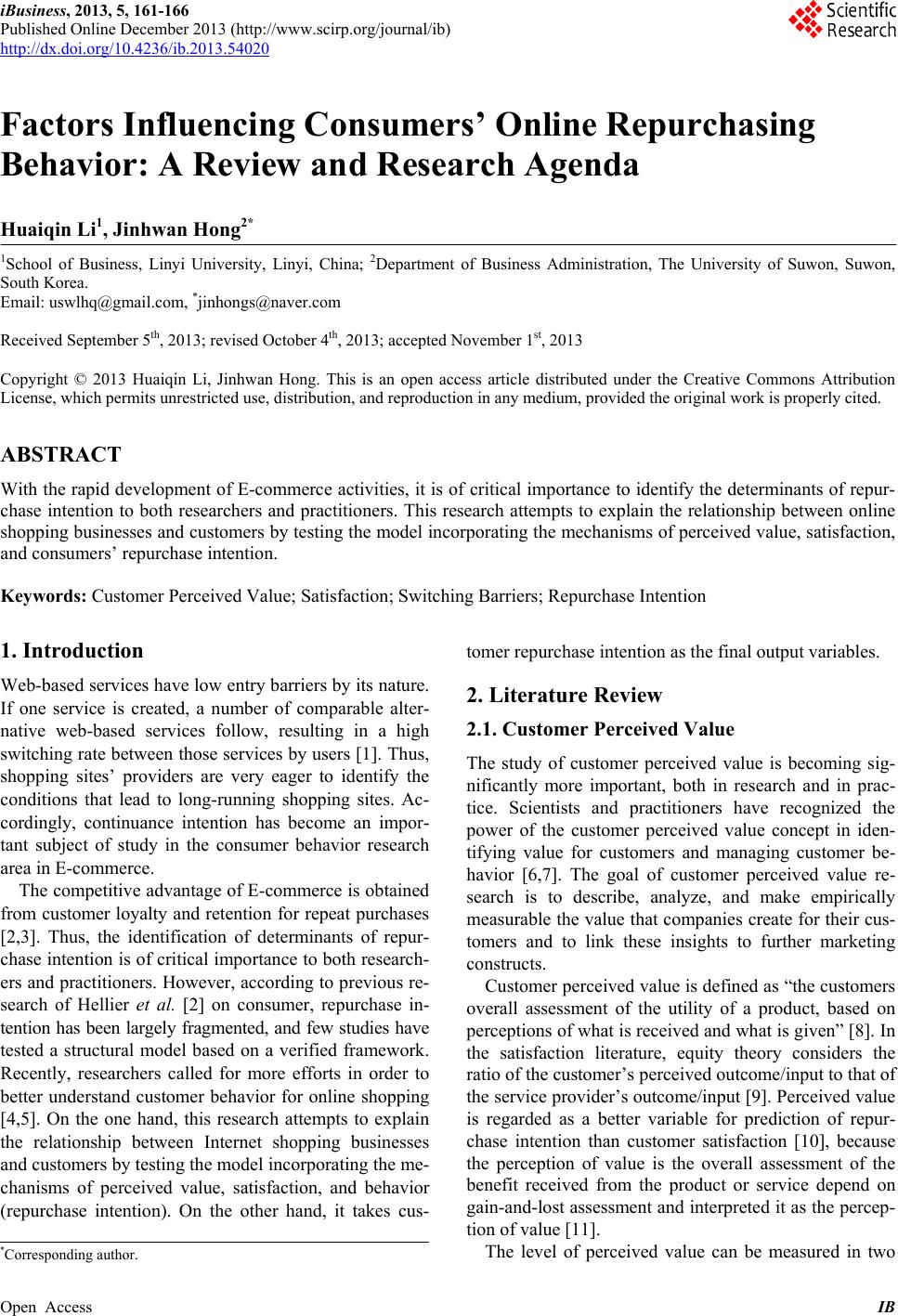 iBusiness, 2013, 5, 161-166 Published Online December 2013 (http://www.scirp.org/journal/ib) http://dx.doi.org/10.4236/ib.2013.54020 Open Access IB 161 Factors Influencing Consumers’ Online Repurchasing Behavior: A Review and Research Agenda Huaiqin Li1, Jinhwan Hong2* 1School of Business, Linyi University, Linyi, China; 2Department of Business Administration, The University of Suwon, Suwon, South Korea. Email: uswlhq@gmail.com, *jinhongs@naver.com Received September 5th, 2013; revised October 4th, 2013; accepted November 1st, 2013 Copyright © 2013 Huaiqin Li, Jinhwan Hong. This is an open access article distributed under the Creative Commons Attribution License, which permits unrestricted use, distribution, and reproduction in any medium, provided the original work is properly cited. ABSTRACT With the rapid dev elopment of E-commerce activities, it is of critical importance to identify the determinants of repur- chase intention to both researchers and practitioners. This research attempts to explain the relationship between online shopping businesses and customers by testing the model incorporating the mechanisms of perceived value, satisfaction, and consumers’ repurchase intention. Keywords: Customer Perceived Value; Satisfaction; Switching Barriers; Repurchase Intention 1. Introduction Web-based services have low entry barriers by its nature. If one service is created, a number of comparable alter- native web-based services follow, resulting in a high switching rate b etween those services by users [1]. Thus, shopping sites’ providers are very eager to identify the conditions that lead to long-running shopping sites. Ac- cordingly, continuance intention has become an impor- tant subject of study in the consumer behavior research area in E-commerce. The competitive advan tage of E-commerce is obtained from customer loyalty and retention for repeat purchases [2,3]. Thus, the identification of determinants of repur- chase intention is of critical importance to both research- ers and practitioners. However, according to prev ious re- search of Hellier et al. [2] on consumer, repurchase in- tention has been largely fragmented, and few studies have tested a structural model based on a verified framework. Recently, researchers called for more efforts in order to better understand customer behavior for online shopping [4,5]. On the one hand, this research attempts to explain the relationship between Internet shopping businesses and customers by testing the model incorporating th e me- chanisms of perceived value, satisfaction, and behavior (repurchase intention). On the other hand, it takes cus- tomer repurchase intention as the final output variables. 2. Literature Review 2.1. Customer Perceived Value The study of customer perceived value is becoming sig- nificantly more important, both in research and in prac- tice. Scientists and practitioners have recognized the power of the customer perceived value concept in iden- tifying value for customers and managing customer be- havior [6,7]. The goal of customer perceived value re- search is to describe, analyze, and make empirically measurable the value that companies create for their cus- tomers and to link these insights to further marketing constructs. Customer perceived value is defined as “the customers overall assessment of the utility of a product, based on perceptions of what is received and what is given” [8]. In the satisfaction literature, equity theory considers the ratio of the customer’s perceived outcome/input to that of the service provider’s outcome/input [9]. Perceived value is regarded as a better variable for prediction of repur- chase intention than customer satisfaction [10], because the perception of value is the overall assessment of the benefit received from the product or service depend on gain-and-lost assessment and interpreted it as the percep- tion of value [11]. The level of perceived value can be measured in two *Corresponding a uthor. 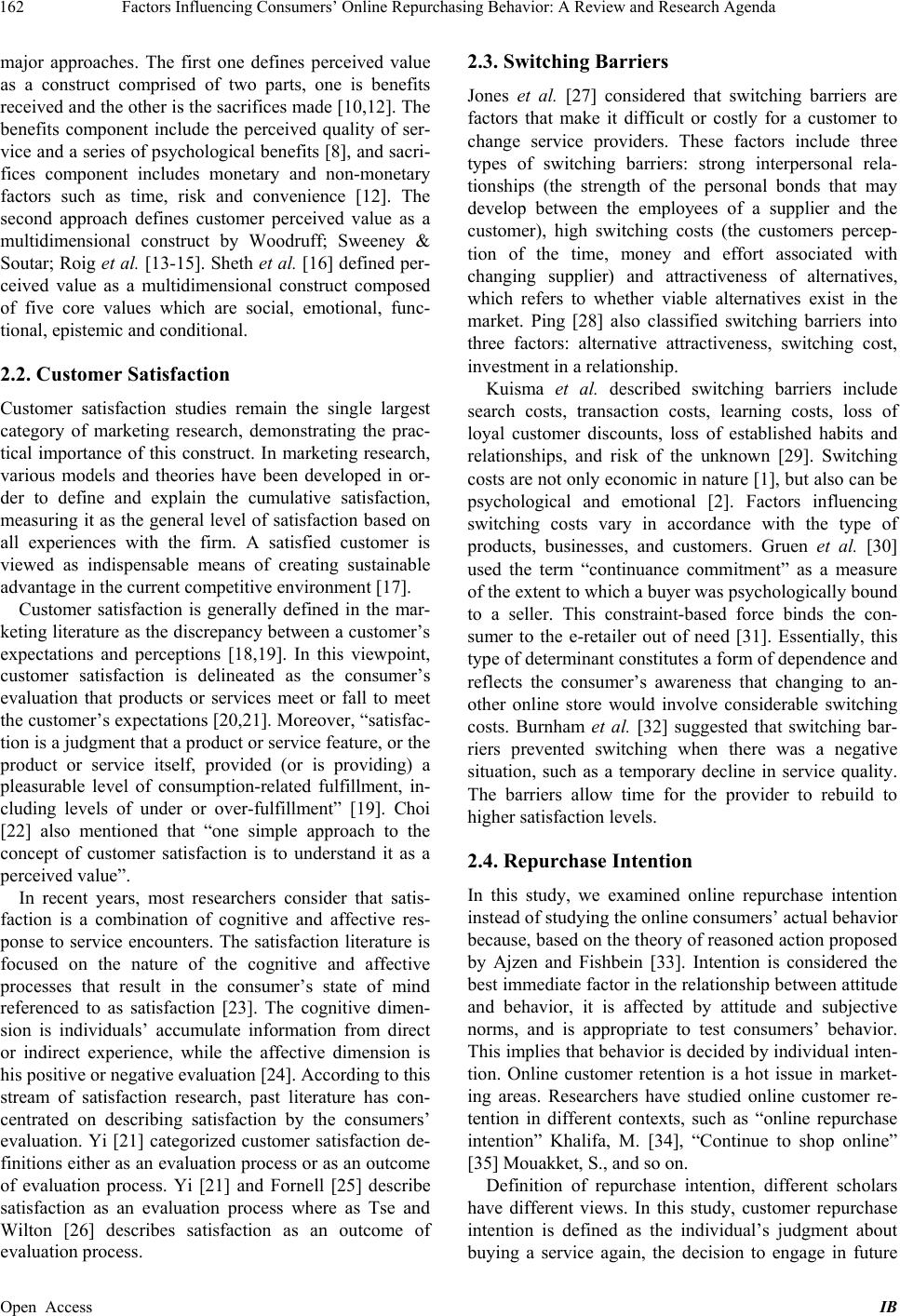 Factors Influencing Consumers’ Online Repurchasing Behavior: A Review and Research Agenda 162 major approaches. The first one defines perceived value as a construct comprised of two parts, one is benefits received and the other is the sacrifices made [10,12]. The benefits component include the perceived quality of ser- vice and a series of psychological benefits [8], and sacri- fices component includes monetary and non-monetary factors such as time, risk and convenience [12]. The second approach defines customer perceived value as a multidimensional construct by Woodruff; Sweeney & Soutar; Roig et al. [13-15]. Sheth et al. [16] defined per- ceived value as a multidimensional construct composed of five core values which are social, emotional, func- tional, epistemic and cond itional. 2.2. Customer Satisfaction Customer satisfaction studies remain the single largest category of marketing research, demonstrating the prac- tical importance of this construct. In marketing research, various models and theories have been developed in or- der to define and explain the cumulative satisfaction, measuring it as the general level of satisfaction based on all experiences with the firm. A satisfied customer is viewed as indispensable means of creating sustainable advantage in the current competitive environment [17]. Customer satisfaction is generally defined in the mar- keting literature as the discrepancy between a cu stomer’s expectations and perceptions [18,19]. In this viewpoint, customer satisfaction is delineated as the consumer’s evaluation that products or services meet or fall to meet the customer’s expectations [20,21]. Moreover, “satisfac- tion is a judgmen t that a product or service feature, or the product or service itself, provided (or is providing) a pleasurable level of consumption-related fulfillment, in- cluding levels of under or over-fulfillment” [19]. Choi [22] also mentioned that “one simple approach to the concept of customer satisfaction is to understand it as a perceived value”. In recent years, most researchers consider that satis- faction is a combination of cognitive and affective res- ponse to service encounters. The satisfaction literature is focused on the nature of the cognitive and affective processes that result in the consumer’s state of mind referenced to as satisfaction [23]. The cognitive dimen- sion is individuals’ accumulate information from direct or indirect experience, while the affective dimension is his positive or negativ e evaluation [24]. According to this stream of satisfaction research, past literature has con- centrated on describing satisfaction by the consumers’ evaluation. Yi [21] categorized customer satisfaction de- finitions either as an evaluation process or as an outcome of evaluation process. Yi [21] and Fornell [25] describe satisfaction as an evaluation process where as Tse and Wilton [26] describes satisfaction as an outcome of evaluati on proce s s . 2.3. Switching Barriers Jones et al. [27] considered that switching barriers are factors that make it difficult or costly for a customer to change service providers. These factors include three types of switching barriers: strong interpersonal rela- tionships (the strength of the personal bonds that may develop between the employees of a supplier and the customer), high switching costs (the customers percep- tion of the time, money and effort associated with changing supplier) and attractiveness of alternatives, which refers to whether viable alternatives exist in the market. Ping [28] also classified switching barriers into three factors: alternative attractiveness, switching cost, investment in a relationship. Kuisma et al. described switching barriers include search costs, transaction costs, learning costs, loss of loyal customer discounts, loss of established habits and relationships, and risk of the unknown [29]. Switching costs are not only economic in nature [1], but also can be psychological and emotional [2]. Factors influencing switching costs vary in accordance with the type of products, businesses, and customers. Gruen et al. [30] used the term “continuance commitment” as a measure of the extent to which a buyer was psychologically bound to a seller. This constraint-based force binds the con- sumer to the e-retailer out of need [31]. Essentially, this type of determinant con stitutes a form of depen dence and reflects the consumer’s awareness that changing to an- other online store would involve considerable switching costs. Burnham et al. [32] suggested that switching bar- riers prevented switching when there was a negative situation, such as a temporary decline in service quality. The barriers allow time for the provider to rebuild to higher satisfaction levels. 2.4. Repurchase Intention In this study, we examined online repurchase intention instead of studying the online consumers’ actu al behavior because, based on the theory of reasoned action proposed by Ajzen and Fishbein [33]. Intention is considered the best immediate factor in the relations hip between attitude and behavior, it is affected by attitude and subjective norms, and is appropriate to test consumers’ behavior. This implies that behavior is decided by individual inten- tion. Online customer retention is a hot issue in market- ing areas. Researchers have studied online customer re- tention in different contexts, such as “online repurchase intention” Khalifa, M. [34], “Continue to shop online” [35] Mouakket, S., and so on. Definition of repurchase intention, different scholars have different views. In this study, customer repurchase intention is defined as the individual’s judgment about buying a service again, the decision to engage in future Open Access IB 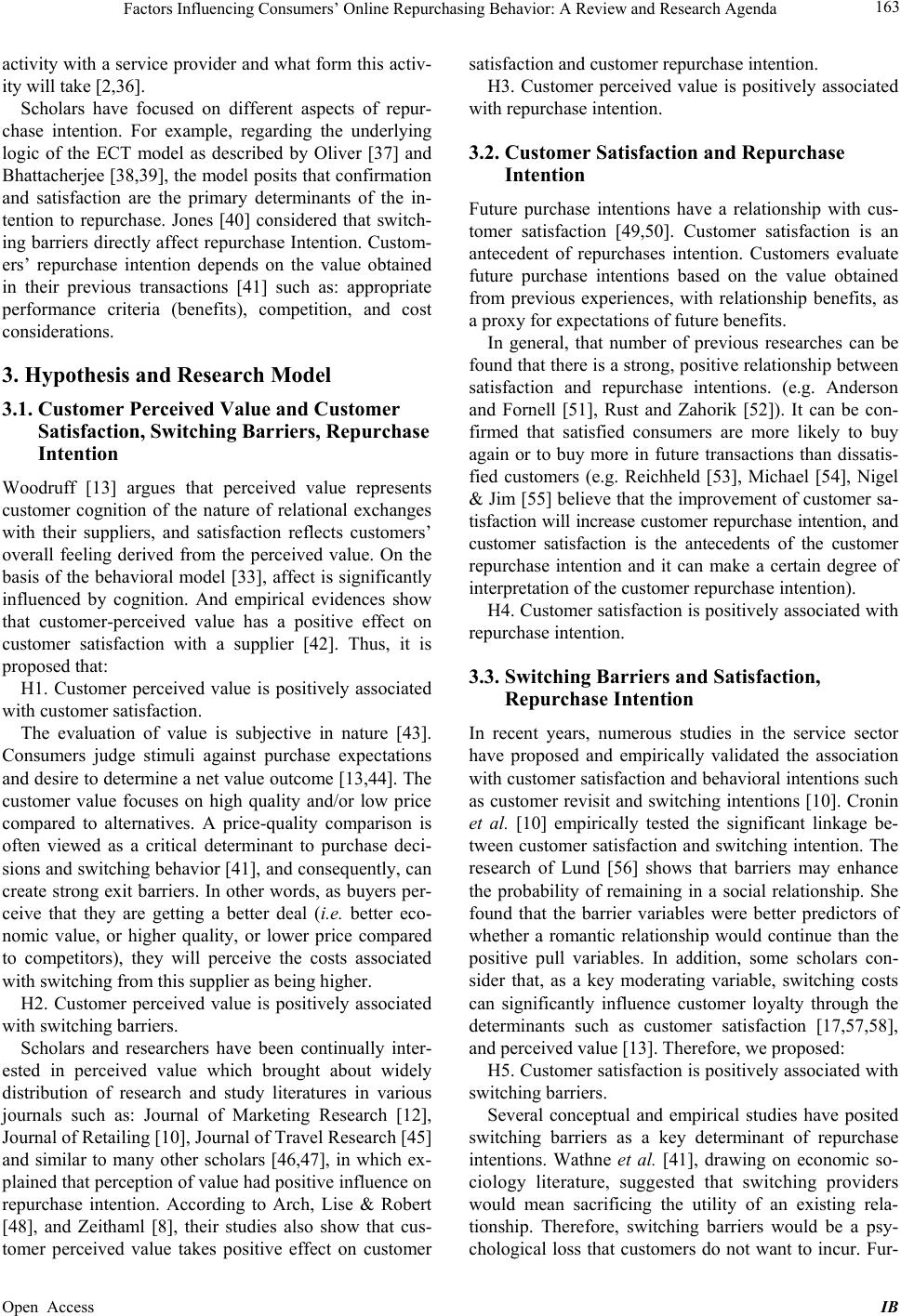 Factors Influencing Consumers’ Online Repurchasing Behavior: A Review and Research Agenda 163 activity with a service provider and what form this activ- ity will take [2,36]. Scholars have focused on different aspects of repur- chase intention. For example, regarding the underlying logic of the ECT model as described by Oliver [37] and Bhattacherjee [38,39], the model posits that confirmation and satisfaction are the primary determinants of the in- tention to repurchase. Jones [40] considered that switch- ing barriers directly affect repurchase Intention. Custom- ers’ repurchase intention depends on the value obtained in their previous transactions [41] such as: appropriate performance criteria (benefits), competition, and cost considerations. 3. Hypothesis and Research Model 3.1. Customer Perceived Value and Customer Satisfaction, Switching Barriers, Repurchase Intention Woodruff [13] argues that perceived value represents customer cognition of the nature of relational exchanges with their suppliers, and satisfaction reflects customers’ overall feeling derived from the perceived value. On the basis of the behavioral model [33], affect is significantly influenced by cognition. And empirical evidences show that customer-perceived value has a positive effect on customer satisfaction with a supplier [42]. Thus, it is proposed that: H1. Customer perceived value is positively associated with customer satisfaction. The evaluation of value is subjective in nature [43]. Consumers judge stimuli against purchase expectations and desire to determine a net value outcome [13,44]. The customer value focuses on high quality and/or low price compared to alternatives. A price-quality comparison is often viewed as a critical determinant to purchase deci- sions and switching behavior [41], and consequently, can create strong exit barriers. In other words, as buyers per- ceive that they are getting a better deal (i.e. better eco- nomic value, or higher quality, or lower price compared to competitors), they will perceive the costs associated with switching from this supplier as being higher. H2. Customer perceived value is positively associated with switching barriers. Scholars and researchers have been continually inter- ested in perceived value which brought about widely distribution of research and study literatures in various journals such as: Journal of Marketing Research [12], Journal of Retailing [10], Journal of Travel Research [45] and similar to many other scholars [46,47], in which ex- plained that p erception o f value h ad positiv e influ ence on repurchase intention. According to Arch, Lise & Robert [48], and Zeithaml [8], their studies also show that cus- tomer perceived value takes positive effect on customer satisfaction and customer repurchase intention. H3. Customer perceived value is positively associated with repurchase intention. 3.2. Customer Satisfaction and Repurchase Intention Future purchase intentions have a relationship with cus- tomer satisfaction [49,50]. Customer satisfaction is an antecedent of repurchases intention. Customers evaluate future purchase intentions based on the value obtained from previous experiences, with relationship benefits, as a proxy for expectations of future benefits. In general, that number of previous researches can be found that there is a strong, positive relationship b etween satisfaction and repurchase intentions. (e.g. Anderson and Fornell [51], Rust and Zahorik [52]). It can be con- firmed that satisfied consumers are more likely to buy again or to buy more in future transactions than dissatis- fied customers (e.g. Reichheld [53], Michael [54], Nigel & Jim [55] believe that the improvement of customer sa- tisfaction will increase customer repurchase intention, and customer satisfaction is the antecedents of the customer repurchase intention and it can make a certain degree of interpretation of the customer repurchase intention). H4. Customer satisfaction is positively associated with repurchase intentio n. 3.3. Switching Barriers and Satisfaction, Repurchase Intention In recent years, numerous studies in the service sector have proposed and empirically validated the association with customer satisfaction and behavioral intentions such as customer revisit and switching intentions [10]. Cronin et al. [10] empirically tested the significant linkage be- tween customer satisfaction and switching in tention. The research of Lund [56] shows that barriers may enhance the probability of remaining in a social relationship. She found that the barrier variables were better predictors of whether a romantic relationship would continue than the positive pull variables. In addition, some scholars con- sider that, as a key moderating variable, switching costs can significantly influence customer loyalty through the determinants such as customer satisfaction [17,57,58], and perceiv ed value [13]. The re fore, we propose d: H5. Customer satisfaction is positively associated with switching barriers. Several conceptual and empirical studies have posited switching barriers as a key determinant of repurchase intentions. Wathne et al. [41], drawing on economic so- ciology literature, suggested that switching providers would mean sacrificing the utility of an existing rela- tionship. Therefore, switching barriers would be a psy- chological loss that customers do not want to incur. Fur- Open Access IB 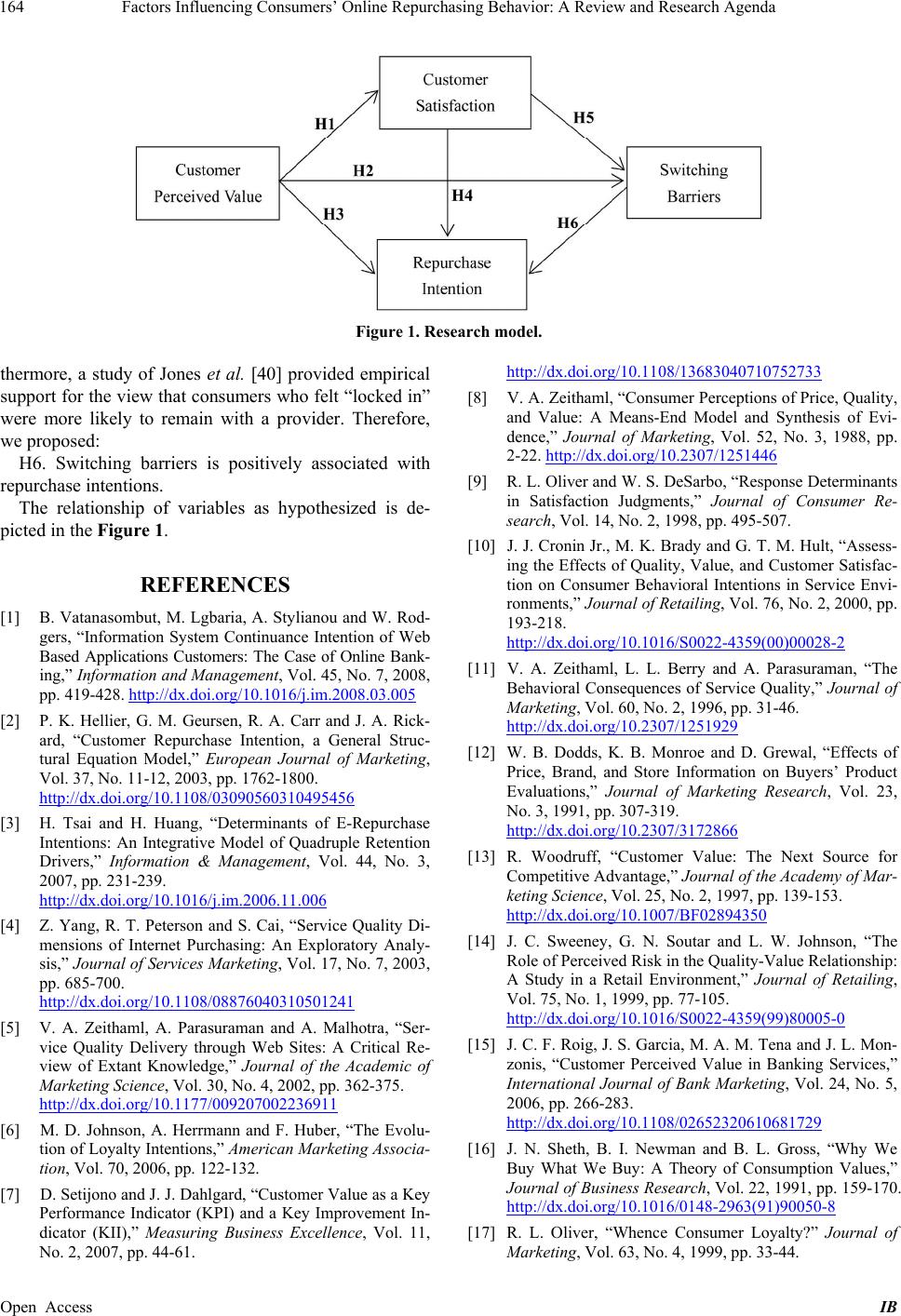 Factors Influencing Consumers’ Online Repurchasing Behavior: A Review and Research Agenda Open Access IB 164 Figure 1. Research model. thermore, a study of Jones et al. [40] provided empirical support for the view that consumers who felt “locked in” were more likely to remain with a provider. Therefore, we proposed: H6. Switching barriers is positively associated with repurchase intentions. The relationship of variables as hypothesized is de- picted in the Figure 1. REFERENCES [1] B. Vatanasombut, M. Lgbaria, A. Stylianou and W. Rod- gers, “Information System Continuance Intention of Web Based Applications Customers: The Case of Online Bank- ing,” Information and Management, Vol. 45, No. 7, 2008, pp. 419-428. http://dx.doi.org/10.1016/j.im.2008.03.005 [2] P. K. Hellier, G. M. Geursen, R. A. Carr and J. A. Rick- ard, “Customer Repurchase Intention, a General Struc- tural Equation Model,” European Journal of Marketing, Vol. 37, No. 11-12, 2003, pp. 1762-1800. http://dx.doi.org/10.1108/03090560310495456 [3] H. Tsai and H. Huang, “Determinants of E-Repurchase Intentions: An Integrative Model of Quadruple Retention Drivers,” Information & Management, Vol. 44, No. 3, 2007, pp. 231-239. http://dx.doi.org/10.1016/j.im.2006.11.006 [4] Z. Yang, R. T. Peterson and S. Cai, “Service Quality Di- mensions of Internet Purchasing: An Exploratory Analy- sis,” Journal of Services Marketing, Vol. 17, No. 7, 2003, pp. 685-700. http://dx.doi.org/10.1108/08876040310501241 [5] V. A. Zeithaml, A. Parasuraman and A. Malhotra, “Ser- vice Quality Delivery through Web Sites: A Critical Re- view of Extant Knowledge,” Journal of the Academic of Marketing Science, Vol. 30, No. 4, 2002, pp. 362-375. http://dx.doi.org/10.1177/009207002236911 [6] M. D. Johnson, A. Herrmann and F. Huber, “The Evolu- tion of Loyalty Intentions,” American Marketing Associa- tion, Vol. 70, 2006, pp. 122-132. [7] D. Setijono and J. J. Dahlgard, “Customer Value as a Key Performance Indicator (KPI) and a Key Improvement In- dicator (KII),” Measuring Business Excellence, Vol. 11, No. 2, 2007, pp. 44-61. http://dx.doi.org/10.1108/13683040710752733 [8] V. A. Zeithaml, “Consumer Perceptions of Price, Quality, and Value: A Means-End Model and Synthesis of Evi- dence,” Journal of Marketing, Vol. 52, No. 3, 1988, pp. 2-22. http://dx.doi.org/10.2307/1251446 [9] R. L. Oliver and W. S. DeSarbo, “Response Determinants in Satisfaction Judgments,” Journal of Consumer Re- search, Vol. 14, No. 2, 1998, pp. 495-507. [10] J. J. Cronin Jr., M. K. Brady and G. T. M. Hult, “Assess- ing the Effects of Quality, Value, and Customer Satisfac- tion on Consumer Behavioral Intentions in Service Envi- ronments,” Journal of Retailing, Vol. 76, No. 2, 2000, pp. 193-218. http://dx.doi.org/10.1016/S0022-4359(00)00028-2 [11] V. A. Zeithaml, L. L. Berry and A. Parasuraman, “The Behavioral Consequences of Service Quality,” Journal of Marketing, Vol. 60, No. 2, 1996, pp. 31-46. http://dx.doi.org/10.2307/1251929 [12] W. B. Dodds, K. B. Monroe and D. Grewal, “Effects of Price, Brand, and Store Information on Buyers’ Product Evaluations,” Journal of Marketing Research, Vol. 23, No. 3, 1991, pp. 307-319. http://dx.doi.org/10.2307/3172866 [13] R. Woodruff, “Customer Value: The Next Source for Competitive Advantage,” Journal of the Academy of Mar- keting Science, Vol. 25, No. 2, 1997, pp. 139-153. http://dx.doi.org/10.1007/BF02894350 [14] J. C. Sweeney, G. N. Soutar and L. W. Johnson, “The Role of Perceived Risk in the Quality-Value Relationship: A Study in a Retail Environment,” Journal of Retailing, Vol. 75, No. 1, 1999, pp. 77-105. http://dx.doi.org/10.1016/S0022-4359(99)80005-0 [15] J. C. F. Roig, J. S. Garc ia, M. A. M. Tena and J. L. Mon- zonis, “Customer Perceived Value in Banking Services,” International Journal of Bank Marketing, Vol. 24, No. 5, 2006, pp. 266-283. http://dx.doi.org/10.1108/02652320610681729 [16] J. N. Sheth, B. I. Newman and B. L. Gross, “Why We Buy What We Buy: A Theory of Consumption Values,” Journal of Business Research, Vol. 22, 1991, pp. 159-170. http://dx.doi.org/10.1016/0148-2963(91)90050-8 [17] R. L. Oliver, “Whence Consumer Loyalty?” Journal of Marketing, Vol. 63, No. 4, 1999, pp. 33-44. 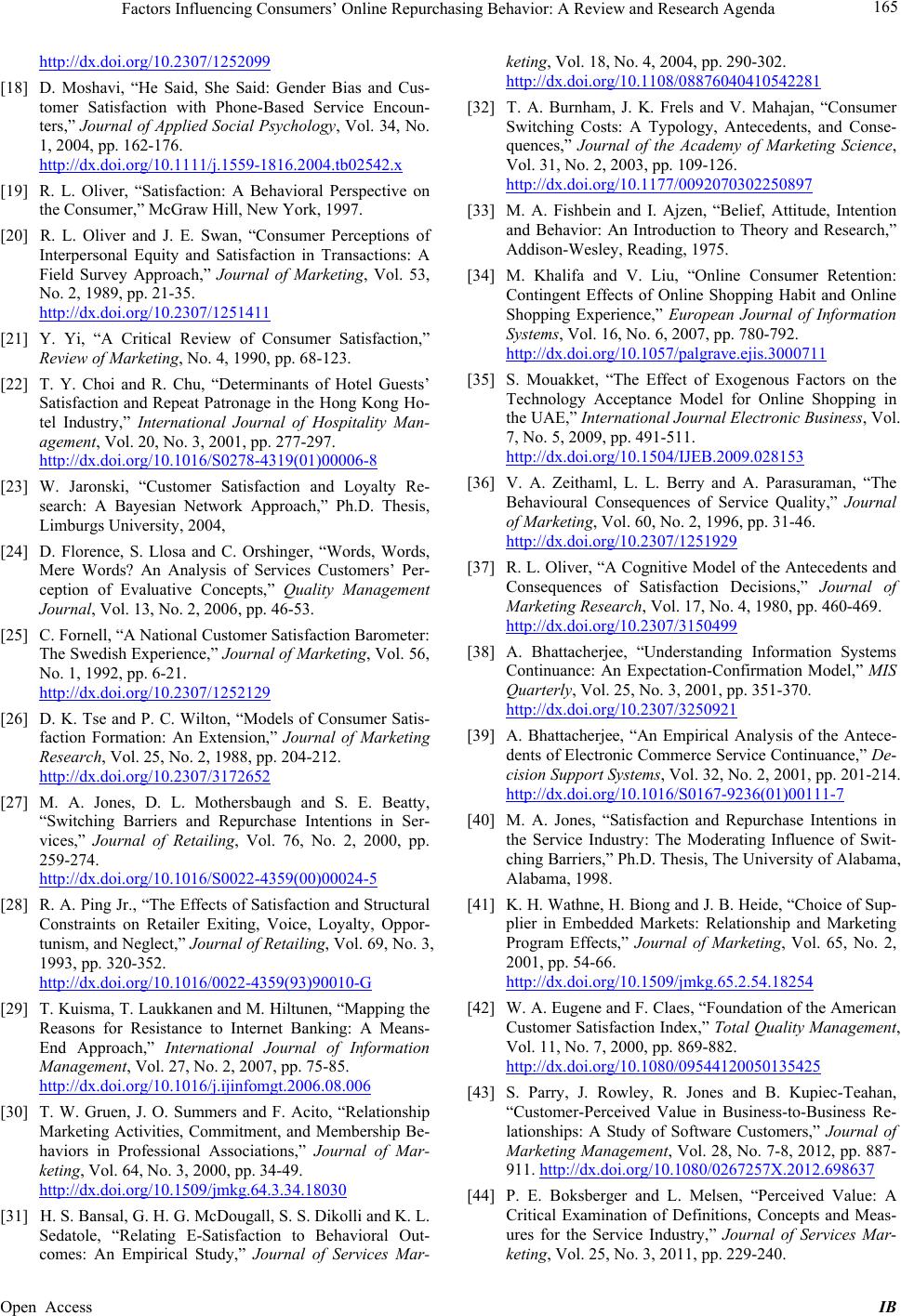 Factors Influencing Consumers’ Online Repurchasing Behavior: A Review and Research Agenda 165 http://dx.doi.org/10.2307/1252099 [18] D. Moshavi, “He Said, She Said: Gender Bias and Cus- tomer Satisfaction with Phone-Based Service Encoun- ters,” Journal of Applied Social Psychology, Vol. 34, No. 1, 2004, pp. 162-176. http://dx.doi.org/10.1111/j.1559-1816.2004.tb02542.x [19] R. L. Oliver, “Satisfaction: A Behavioral Perspective on the Consumer,” McGraw Hill, New York, 1997. [20] R. L. Oliver and J. E. Swan, “Consumer Perceptions of Interpersonal Equity and Satisfaction in Transactions: A Field Survey Approach,” Journal of Marketing, Vol. 53, No. 2, 1989, pp. 21-35. http://dx.doi.org/10.2307/1251411 [21] Y. Yi, “A Critical Review of Consumer Satisfaction,” Review of Marketing, No. 4, 1990, pp. 68-123. [22] T. Y. Choi and R. Chu, “Determinants of Hotel Guests’ Satisfaction and Repeat Patronage in the Hong Kong Ho- tel Industry,” International Journal of Hospitality Man- agement, Vol. 20, No. 3, 2001, pp. 277-297. http://dx.doi.org/10.1016/S0278-4319(01)00006-8 [23] W. Jaronski, “Customer Satisfaction and Loyalty Re- search: A Bayesian Network Approach,” Ph.D. Thesis, Limburgs University, 2004, [24] D. Florence, S. Llosa and C. Orshinger, “Words, Words, Mere Words? An Analysis of Services Customers’ Per- ception of Evaluative Concepts,” Quality Management Journal, Vol. 13, No. 2, 2006, pp. 46-53. [25] C. Fornell, “A National Customer Satisfaction Barometer: The Swedish Experience,” Journal of Marketing, Vol. 56, No. 1, 1992, pp. 6-21. http://dx.doi.org/10.2307/1252129 [26] D. K. Tse and P. C. Wilton, “Models of Consumer Satis- faction Formation: An Extension,” Journal of Marketing Research, Vol. 25, No. 2, 1988, pp. 204-212. http://dx.doi.org/10.2307/3172652 [27] M. A. Jones, D. L. Mothersbaugh and S. E. Beatty, “Switching Barriers and Repurchase Intentions in Ser- vices,” Journal of Retailing, Vol. 76, No. 2, 2000, pp. 259-274. http://dx.doi.org/10.1016/S0022-4359(00)00024-5 [28] R. A. Ping Jr., “The Effects of Satisfaction and Structural Constraints on Retailer Exiting, Voice, Loyalty, Oppor- tunism, and Neglect,” Journal of Retailing, Vol. 69, No. 3, 1993, pp. 320-352. http://dx.doi.org/10.1016/0022-4359(93)90010-G [29] T. Kuisma, T. Laukkanen and M. Hiltunen, “Mapping the Reasons for Resistance to Internet Banking: A Means- End Approach,” International Journal of Information Management, Vol. 27, No. 2, 2007, pp. 75-85. http://dx.doi.org/10.1016/j.ijinfomgt.2006.08.006 [30] T. W. Gruen, J. O. Summers and F. Acito, “Relationship Marketing Activities, Commitment, and Membership Be- haviors in Professional Associations,” Journal of Mar- keting, Vol. 64, No. 3, 2000, pp. 34-49. http://dx.doi.org/10.1509/jmkg.64.3.34.18030 [31] H. S. Bansal, G. H. G. McDougall, S. S. Dikolli and K. L. Sedatole, “Relating E-Satisfaction to Behavioral Out- comes: An Empirical Study,” Journal of Services Mar- keting, Vol. 18, No. 4, 2004, pp. 290-302. http://dx.doi.org/10.1108/08876040410542281 [32] T. A. Burnham, J. K. Frels and V. Mahajan, “Consumer Switching Costs: A Typology, Antecedents, and Conse- quences,” Journal of the Academy of Marketing Science, Vol. 31, No. 2, 2003, pp. 109-126. http://dx.doi.org/10.1177/0092070302250897 [33] M. A. Fishbein and I. Ajzen, “Belief, Attitude, Intention and Behavior: An Introduction to Theory and Research,” Addison-Wesley, Reading, 1975. [34] M. Khalifa and V. Liu, “Online Consumer Retention: Contingent Effects of Online Shopping Habit and Online Shopping Experience,” European Journal of Information Systems, Vol. 16, No. 6, 2007, pp. 780-792. http://dx.doi.org/10.1057/palgrave.ejis.3000711 [35] S. Mouakket, “The Effect of Exogenous Factors on the Technology Acceptance Model for Online Shopping in the UAE,” International Journal Electronic Business, Vol. 7, No. 5, 2009, pp. 491-511. http://dx.doi.org/10.1504/IJEB.2009.028153 [36] V. A. Zeithaml, L. L. Berry and A. Parasuraman, “The Behavioural Consequences of Service Quality,” Journal of Marketing, Vol. 60, No. 2, 1996, pp. 31-46. http://dx.doi.org/10.2307/1251929 [37] R. L. Oliver, “A Cognitive Model of the Antecedents and Consequences of Satisfaction Decisions,” Journal of Marke ting R esearch, Vol. 17, No. 4, 1980, pp. 460-469. http://dx.doi.org/10.2307/3150499 [38] A. Bhattacherjee, “Understanding Information Systems Continuance: An Expectation-Confirmation Model,” MIS Quarterly, Vol. 25, No. 3, 2001, pp. 351-370. http://dx.doi.org/10.2307/3250921 [39] A. Bhattacherjee, “An Empirical Analysis of the Antece- dents of Electronic Commerce Service Continuance,” De - cision Support Systems, Vol. 32, No. 2, 2001, pp. 201-214. http://dx.doi.org/10.1016/S0167-9236(01)00111-7 [40] M. A. Jones, “Satisfaction and Repurchase Intentions in the Service Industry: The Moderating Influence of Swit- ching Barriers,” Ph.D. Thesis, The University of Alabama, Alabama, 1998. [41] K. H. Wathne, H. Biong and J. B. Heide, “Choice of Sup- plier in Embedded Markets: Relationship and Marketing Program Effects,” Journal of Marketing, Vol. 65, No. 2, 2001, pp. 54-66. http://dx.doi.org/10.1509/jmkg.65.2.54.18254 [42] W. A. Eugene and F. Claes, “Foundation of the American Customer Satisfaction Index,” Total Quality Management, Vol. 11, No. 7, 2000, pp. 869-882. http://dx.doi.org/10.1080/09544120050135425 [43] S. Parry, J. Rowley, R. Jones and B. Kupiec-Teahan, “Customer-Perceived Value in Business-to-Business Re- lationships: A Study of Software Customers,” Journal of Marketing Management, Vol. 28, No. 7-8, 2012, pp. 887- 911. http://dx.doi.org/10.1080/0267257X.2012.698637 [44] P. E. Boksberger and L. Melsen, “Perceived Value: A Critical Examination of Definitions, Concepts and Meas- ures for the Service Industry,” Journal of Services Mar- keting, Vol. 25, No. 3, 2011, pp. 229-240. Open Access IB  Factors Influencing Consumers’ Online Repurchasing Behavior: A Review and Research Agenda 166 http://dx.doi.org/10.1108/08876041111129209 [45] J. F. Petrick and S. J. Beckman, “An Examination of the Construct of Perceived Value for the Prediction of Golf Travelers’ Intentions to Revisit,” Journal of Travel Re- search, Vol. 41, No. 4, 2002, pp. 38-45. [46] J. L. M. Tam, “The Effects of Service Quality, Perceived Value and Customer Satisfaction on Behavioral Inten- tions,” Journal of Hospitality and Leisure Marketing, Vol. 6, No. 4, 2000, pp. 31-43. [47] M. Pura, “Linking Perceived Value and Loyalty in Loca- tion-Based Mobile Services,” Journal of Marketing Re- search, Vol. 28, No. 3, 1991, pp. 307-319. [48] G. W. Arch, F. Lise and T. D. Robert, “Linking Service Quality, Customer Satisfaction and Behavior Intention,” Journal of Healthcare Marketing, Vol. 11, No. 4, 1989, pp. 5-17. [49] P. G. Patterson, L. W. Johnson and R. A. Spreng, “Mod- eling the Determinants of Customer Satisfaction for Busi- ness to Business Professional Services,” Journal of the Academy of Marketing Science, Vol. 25, No. 1, 1997, pp. 4-17. http://dx.doi.org/10.1007/BF02894505 [50] S. Durvasula, S. Lysonski, S. C. Mehta and B. P. Tang, “Forging Relationships with Services: The Antecedents that have an Impact on Behavioural Outcomes in the Life Insurance Industry,” Journal of Financial Services Mar- keting, Vol. 8, No. 4, 2004, pp. 314-326. http://dx.doi.org/10.1057/palgrave.fsm.4770129 [51] E. W. Anderson and C. Fornell, “A Customer Satisfaction Research Prospectus,” In: R. T. Rust and R. Oliver, Eds., Service Quality: New Directions in Theory and Practice, Sage Publications, Thousand Oaks, 1994, pp. 241-268. http://dx.doi.org/10.4135/9781452229102.n11 [52] R. T. Rust and A. J. Zahorik, “Customer Satisfaction, Customer Retention, and Market Share,” Journal of Re- tailing, Vol. 69, No. 2, 1993, pp. 193-215. http://dx.doi.org/10.1016/0022-4359(93)90003-2 [53] F. Reichheld, “The Loyalty Effect,” Harvard Business School Press, Boston, 1996. [54] M. D. Johnson, A. Gustafaaon, T. W. Andreassen, L. Ler- vik and J. Cha, “The Evolution and Future of National Customer Satisfaction Index Models,” Journal of Eco- nomic Psychology, Vol. 22, No. 2, 2001, pp. 217-245. http://dx.doi.org/10.1016/S0167-4870(01)00030-7 [55] H. Nigel and A. Jim, “Handbook of Customer Satisfac- tion and Loyalty Measurment,” 3rd Edition, Gower Pub- lishing Co, Bodmin, 2002, pp. 22-23. [56] M. Lund, “The Development of Investment and Commit- ment Scales for Predicting Continuity of Personal Rela- tionships,” Journal of Social and Personal Relationships, Vol. 2, No. 1, 1985, pp. 3-23. http://dx.doi.org/10.1177/0265407585021001 [57] C. Fornell, “A National Customer Satisfaction Barometer: The Swedish Experience,” Journal of Marketing, Vol. 56, No. 1, 1992, pp. 6-21. http://dx.doi.org/10.2307/1252129 [58] G. Balabanis, N. Reynolds and A. Simintiras, “Bases of E-Store Loyalty: Perceived Switching Barriers and Satis- faction,” Journal of Business Research, Vol. 59, No. 2, 2006, pp. 214-224. http://dx.doi.org/10.1016/j.jbusres.2005.06.001 Open Access IB
|